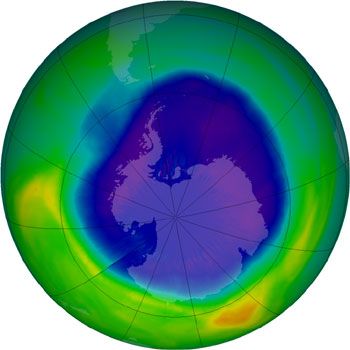March 9, 2011
2010 Ozone Hole Is Third Smallest Since 1990: JMA Reports
Keywords: Ecosystems / Biodiversity Government
The Japan Meteorological Agency (JMA) released on October 27, 2010, the current status of the ozone hole by analyzing satellite data from the National Aeronautics and Space Administration (NASA). According to the JMA, the Ozone hole in 2010 expanded after its appearance in August, reaching its annual maximum size of 21.9 million square kilometers on Sept.25, which was the third smallest since 1990. It may be because the area of stratospheric cold air over the Antarctic region, which accelerates ozone destruction, had been smaller than usual from mid-July through August.
The size of ozone hole fluctuates with changes in the stratospheric weather conditions over the Antarctic region each year. The ozone hole usually grows to a maximum size by early October. Subsequently, as the Antarctic vortex, which is closely linked to the growing and shrinking of the ozone hole, becomes weaker, the ozone hole gradually becomes smaller until it disappears in November through December.
Over the long term, however, the size of the hole is affected by concentrations of ozone-depleting substances in the stratosphere. Although the concentrations of these substances are gradually declining, they remain high and require continued careful monitoring. According to the "Scientific Assessment of Ozone Depletion: 2010" compiled by WMO (World Meteorological Organization) and UNEP (United Nations Environment Programme), the Antarctic ozone hole is projected to recover to pre-1980 levels in the second half of this century.
2007 Ozone Hole Looms over Antarctica, as for the Past Decade (Related JFS article)
http://www.japanfs.org/en/pages/026890.html
Posted: 2011/03/09 06:00:15 AM
Reference
Japan Meteorological Agency (JMA) official website
http://www.jma.go.jp/jma/indexe.html
Related
"JFS Newsletter"
- 'What Are the Roles of Zoos Today?' - Interview with Director of the Popular Asahiyama Zoo
- Nishiawakura's Initiative for 100% Energy Self-Sufficiency, and a Municipal ICO Scheme
- 15-Year Integrated Forest Environment Education in Shimokawa, Hokkaido to Support Sustainable Forest Management
- Fifth Contest to Award Excellent Environmental and Social Practices by Junior High, High School Students
- Increase Revenues without Increasing Catches -- How the Sustainable Sakura Shrimp Fishery in Suruga Bay Does It



